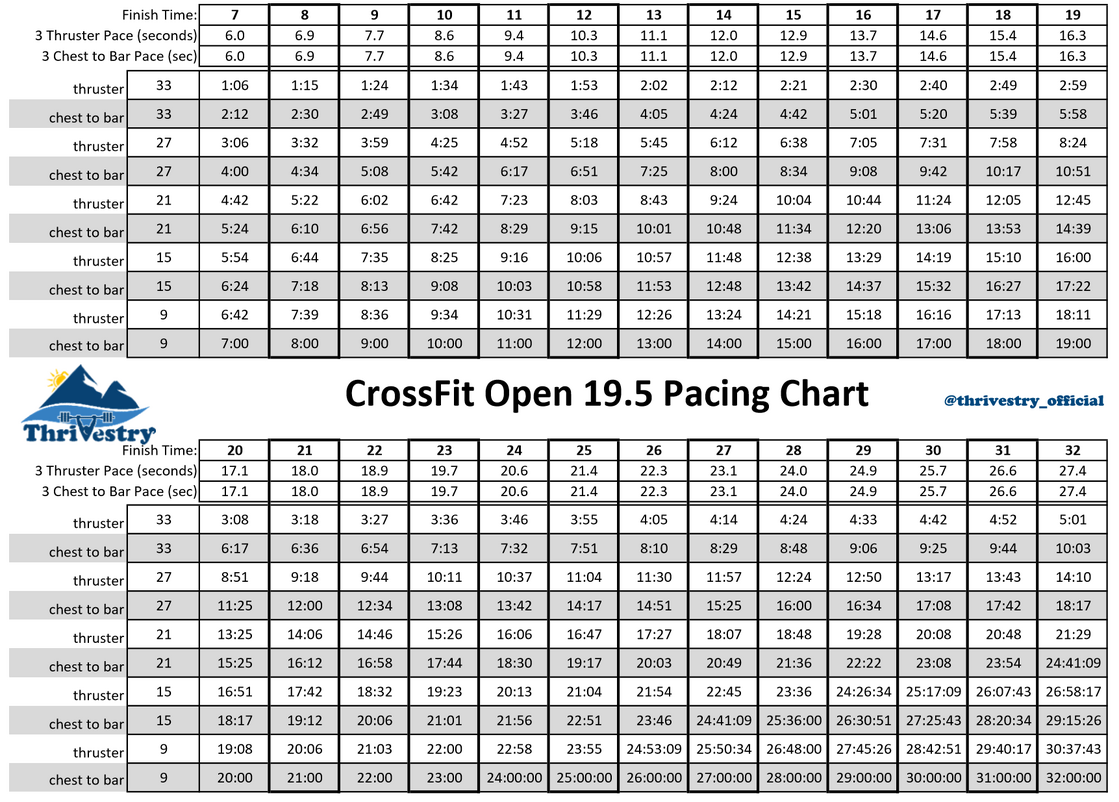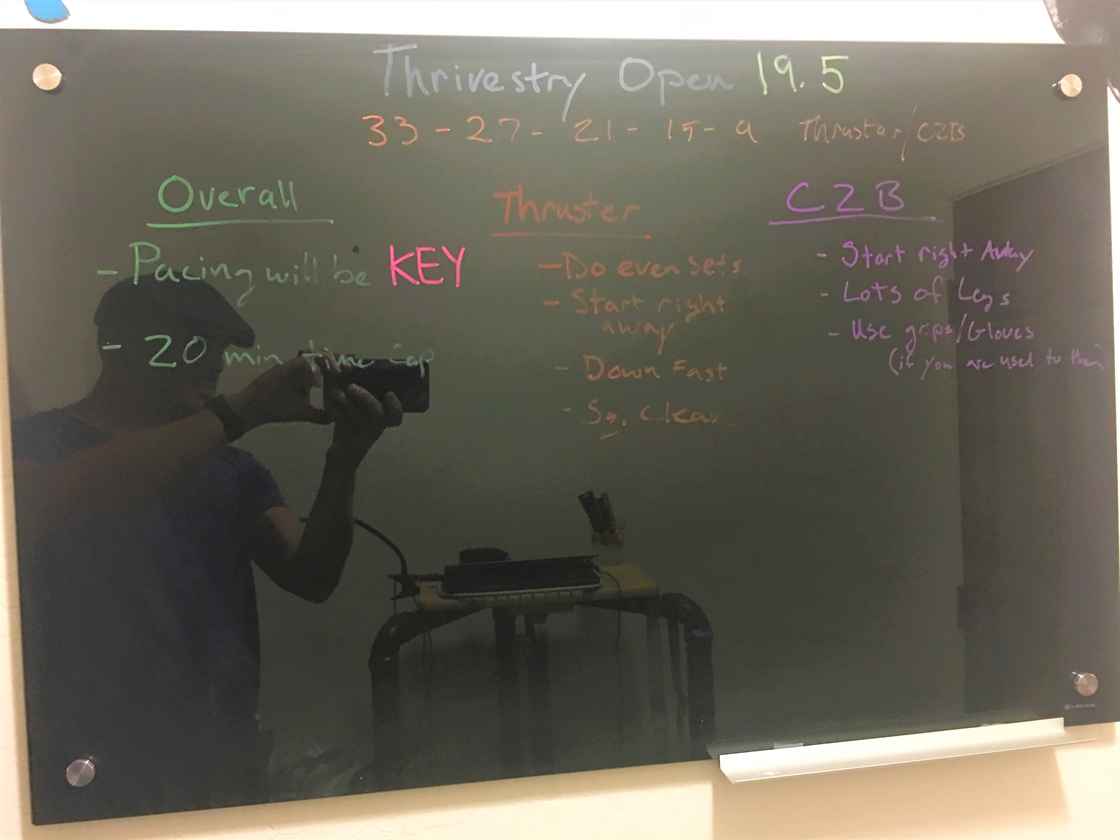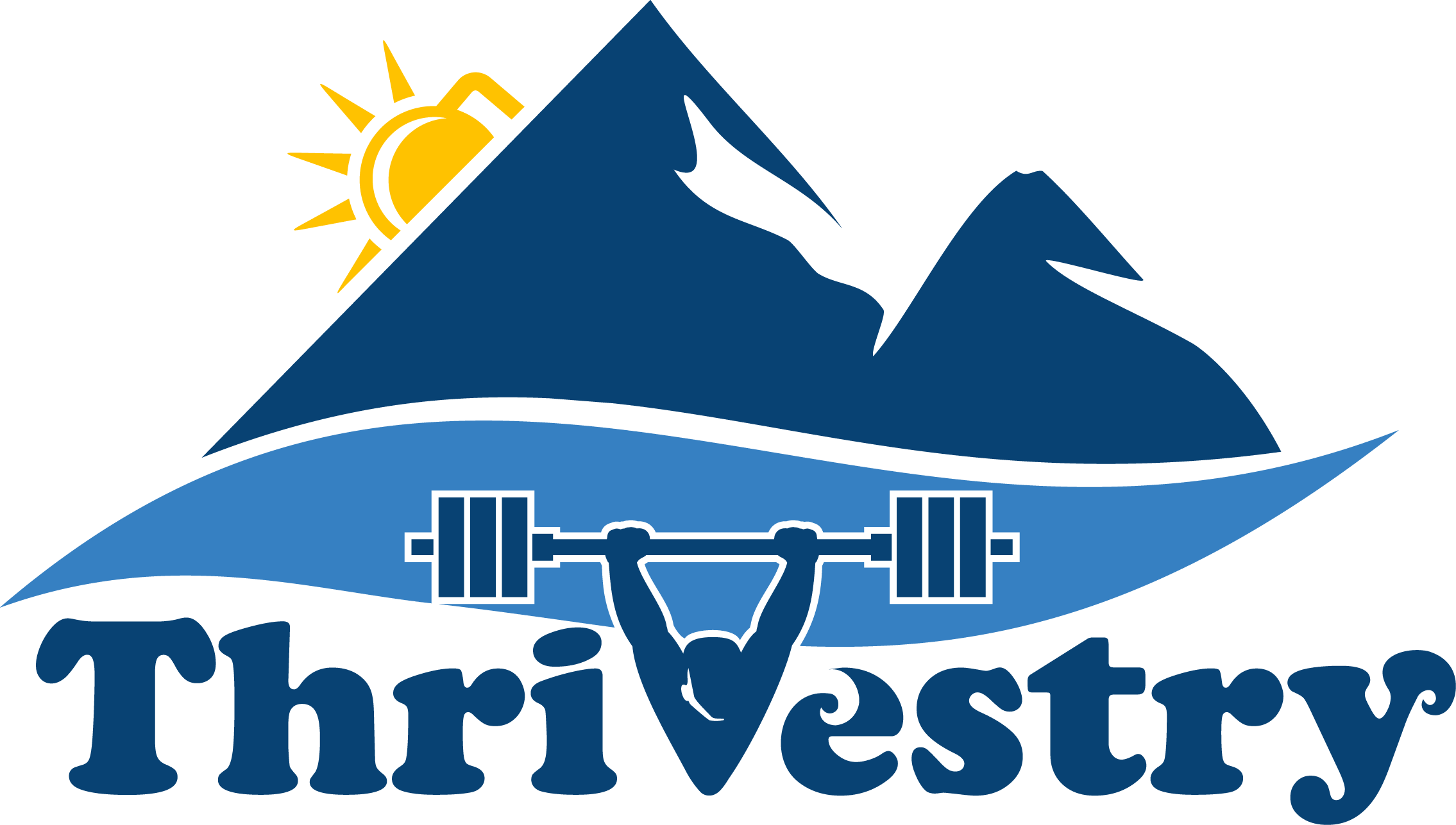CrossFit Open 19.5 Breakdown and Tips
This one is a doozy!
CrossFit Open 19.5 is 33-27-21-15-9 of thrusters and chest to bar pull ups (20-minute mercy killin… I mean “TIME CAP”).
Overall
The most important thing for just about everyone will be pacing correctly. Come out too fast and you’ll be sure to get a score that doesn’t reflect your fitness. Start out too slow and you’ll always wonder if you could have gone faster.
Enter: The Pacing Chart
Pacing workouts with varying numbers of reps per round is always difficult. When these workouts come up, I like to use some of the spreadsheet magic I use in making daily gym programming to help people have a good showing.
Here is what I came up with (Here is a PDF version for easy printing: CrossFit Open 19point5 pacing chart.pdf).

Notes for the pacing chart:
The top row is the finish you are shooting for.
If you do not know what you’ll be able to do, test an easy set of 12 or 15 thrusters and 12 or 15 chest to bars. It should be super EASY. Break each set up at least once. Use this to find your time for 3 reps (if you did 15 & 15 for example, divide your combined time by 6 – 3 reps for the thrusters and 3 reps for the pull ups). This will give you a rough estimate of how long 3 reps took you.
Use that time to look at the pacing chart and select a column that you think you’ll be able to maintain. I will say that you’ll probably want to go one column (or two) to the right. Even if you thought you were moving slow on the test, chances are that you were still going fast compared to what you’ll be able to sustain on the workout.
For this chart, I balanced the thruster time with the chest to pull up time. This is highly dependent upon your own personal strengths, but this does assume that you’ll need to break up the pull ups significantly. So even though it takes less time to do 3 chest to bars, you’ll still want to pace these out so you get a bit more rest between sets of thrusters (and to save your hands).
More than looking at each movement row, look at the whole round (the time when the pull ups are done).
If you can sustain a pace of 8-9 seconds for 3 thrusters and 8-9 seconds for 3 chest to bar, AND you can easily finish 33 thrusters and 33 pull ups in 3:08 or less… you have a chance of finishing in 10 minutes or so.
If you can sustain 3 thrusters every 17 seconds and 3 chest to bars every 17 seconds, AND you can finish 33/33 in 6:17 or faster, you have a chance of finishing under the time cap!
The key word here is SUSTAIN. You have to be able to maintain this pace for the entire workout (so going faster early on isn’t a guarantee of success if you blow up).
Print this chart and then highlight your target column. Have a super friend (not your judge) help you stay on time without going too fast. You’ll know you paced correctly if you get to the 15s and you aren’t completely crushed and you have some gas to go a bit faster.
Alternatively, you can take the pacing numbers and write them on your score card or whiteboard beforehand and use that to help you stay on pace.
Pacing for People Hitting the Time Cap
You’ll notice that the times go well beyond the 20-minute mark. I went ahead and extended the spreadsheet to include pacing for people who will be time capped.
If these movements, in this volume, are going to be challenging for you, you can still use the pacing guide! Use the test above to find your pace, and then work off of the column that matches your pace. In this case, you may want to pick a column (or two) to the left (going faster than your test indicated). You can go faster than the ‘for time’ folks because you will be less total reps.
Warm Up
Prior to the workout, you’ll want to make sure you are thoroughly warmed up so you can move efficiently from the beginning. Here is an example:
Dynamic Warm up: 2 min easy row or airdyne. Then 3 sets of 10 kb halos, 10 push ups, 10 kip swings, 10 hollow rocks. Then 3 sets of 5 with the empty bar: hang squat clean, push press, thruster
Mobility: Focus on shoulder mobility for going overhead, the front rack, and opening the shoulder on pull ups. If you have time, work on the hips to help with staying upright in the bottom of the squat.
Thrusters
Plan on breaking these up into ‘small sets’ early and often! Use sets that are close in reps.
For example, for most people it is better to do 6, 6, 6, 5, 5, 5 on the first round rather than 15, 10, 8. By setting an even pace early on, it will ensure that you’ll be able to maintain that pace in the later rounds.
That said, I am a fan of doing a small set right after the transition from the other movement, then doing decreasing sets (as long as they are similar in size).
One example might be:
For the 33s
- Thrusters: 9, 6, 6, 6, 6
- Pull Ups: 6, 9, 6, 6, 3, 3
For the 27s:
- Thrusters: 4, 8, 5, 4, 4, 3
- Pull ups: 4, 6, 5, 4, 4, 4
For the 21s:
- Thrusters: 4, 5, 5, 4, 3
- Pull Ups: 4, 5, 5, 4, 3
For the 15s:
- Thrusters: 3, 5, 4, 3
- Pull Ups: 3, 5, 4, 3
For the 9s:
- Thrusters: 3, 3, 3 (or 4, 5)
- Pull Ups: 4, 5
Remember to use your hips to get the bar overhead! Make sure you are accelerating at the top of the squat to rocket that bar over the head. Do not get into the habit of using a lot of arm press.
If this is a ‘light’ load for you, you may want to keep the bar in the hands and the elbows pointed down (as opposed to using the front rack position). This is a faster thruster, but it only works if you have the strength to hold the bar there!
‘Sneak Unders’ or squat cleans are allowed! That means that you don’t have to do a full power clean before initiating the squat. ‘Sneak Unders’ are where you do the minimal amount of pull before curling the weight and getting to the bottom of the squat. They aren’t the most efficient, but they are faster. If the barbell load isn’t a challenge for you, these can pay if because of all the breaks.
Also a factor if the load isn’t much of a problem for you: free fall. Thrusters are one of the few movements that really benefit from focusing on going ‘down fast’. If you try to keep the bar under control through the entire movement, you will use more energy. One of the secrets of the folks that have silly fast Fran times is that they aren’t working on the way down. They are trying to ‘pull’ the bar down (they don’t actually pull, but the intent means that they relax the right muscles and move much more efficiently).
Be careful with this technique unless you have a thruster max that is more than double the prescribed load and you don’t have a good vertical torso at the bottom. Having that bar come crashing down on you without the requisite strength and positioning can be dangerous for you back!
You are going to be better off minimizing the transition from the pull ups and just getting some reps on the board. Don’t take the time to think about it! Get started right away, but be prepared to drop if it ‘feels heavy’.
When people have a big set in mind, they will take too long to pick up the bar. It is better to get started right away and getting started with a small set. No chalk. No water. Get some reps on the board and use your next rest within the movement sets to do that stuff!
Chest to Bar Pull Ups
One thing that people always forget when doing kipping pull ups is that the power is generated from the lower body. Make sure you are using your hips to get your body up, starting from the first rep to the last!
Chest to bar pull ups are also where you will want to pace this workout. It is much easier to ‘let go’ of a pull up (and not do the negative), then jump back up, than it is to pick up the barbell after dropping it. Even if you are ‘pull up ninja’, breaking these up will help you pace the workout better if it allows you to do larger sets of thrusters.
Another tip for pull ups is to really drive the elbows back, expanding the chest. Using that intent, you will avoid no reps because you are using your arms and your back as well (there is a reason why we program so many ring rows and barbell/dumbbell rows)!
If grip is an issue (or if you have mobility problems), change up your grip. Doing a mixed grip (one hand palm away, and one hand facing you) may avoid rips, and it may get you some extra range of motion.
For pacing, small sets will be the way to go. Do not discredit singles! Steady singles with a release at the top may be a bit slower, but they can use less energy, and allow you to do the thrusters faster! Keep in mind that 3 reps every 12 seconds will still get you a 14 minute time!
As far as butterfly pull ups go, only use them if you are comfortable with them. They are going to be faster and more efficient if your grip can take it. Make sure you ‘lean back’ and that the bar is hitting at the sternum or lower. If you haven’t gotten good at these yet, do not ‘confuse’ yourself by trying to master them for this workout. Stick to what you can do consistently.

Mindset
This is a marathon not a sprint. Use the pacing guide as a ‘reality check’ to make sure you aren’t going too fast in the earlier rounds. KEEP IN MIND THAT THE FIRST TWO ROUNDS IS MORE THAN HALF OF THE REPS! (120 reps of 210)
If you pace the first two rounds correctly, this should be about halfway through your total time.
Do not get ‘sucked in’ to what other people are doing around you. Stick to the plan and stay on schedule. It is okay to be a bit ahead of schedule, but if you are crushing your goal at the end of round 1, you are probably going too fast. Slow down, and then speed up on the later rounds if you still have gas in the tank.
You will also want to minimize that transition time between movements. Go right into the other movement to get some reps on the board. The plan for your first set should be deliberately small, so you don’t spend extra time ‘thinking’ about how hard that set is going to feel.
Shoes and Belt (and Gloves)?
You may consider Olympic lifting shoes if you have trouble staying upright in the bottom of the squat. The extra weight won’t make much of a difference on the pull ups!
I wouldn’t recommend a belt, but if you know your back is going to blow up on the thrusters, you may want to start with one at least for the first 3 rounds (it is easy to strip it off when the rounds get shorter).
If you haven’t used grips or gloves before, you probably won’t want to start now. As a general rule, you do not want to use things that you haven’t gotten used to. THAT SAID, if you have some experience with these and you are unsure, start with them for the first round or two. They may save your hands for the later rounds, and it is always easier to take them off than it is to put them on later on.
Repeat?
This one is going to make you extremely sore and possibly shred your hands. I wouldn’t recommend it for most folks.
If this is your last shot at making the age qualifier, or you have some reason for caring about your leaderboard score, you ‘might’ think about a repeat. It is also important to point out that there are less people still participating in the Open, and a repeat is less likely to help you since there are less ‘points’ to gain.
You’ll want to keep in mind that after 4 weeks of Open workouts, you are going to be predisposed to injury. Jacking your back up or shredding your hands isn’t a winning strategy long term because it will upset your training. And with the next Open happening 7-8 months away… every week of training counts!
What Now?
And finally, this is the end of the Open. It is another year (or your first year) in the books. While you may look forward to moving on and getting back to regular training, it is important that you gleam every drop of experience that you can.
Journal what went right this year and what went not-so-right.
How could you have been better prepared? What could you have done differently?
Paste these notes onto you calendar for reminders 2-3 times over the next 7-8 months so that you can keep you routines focused on improving for next year.
And no matter how you finished, remember that you PRed the number of Open workouts you have competed in!
You finished ‘ahead’ of everyone who didn’t throw their hat into the ring. Do not let the leaderboard get in your head (because there is about 80-90% of folks who didn’t even sign up).
Spend the next few weeks doing activities that you enjoy (in an outside of the gym). Recharge and get ready for the next big challenge!
Have fun!
-jj

0 comments
Leave a comment